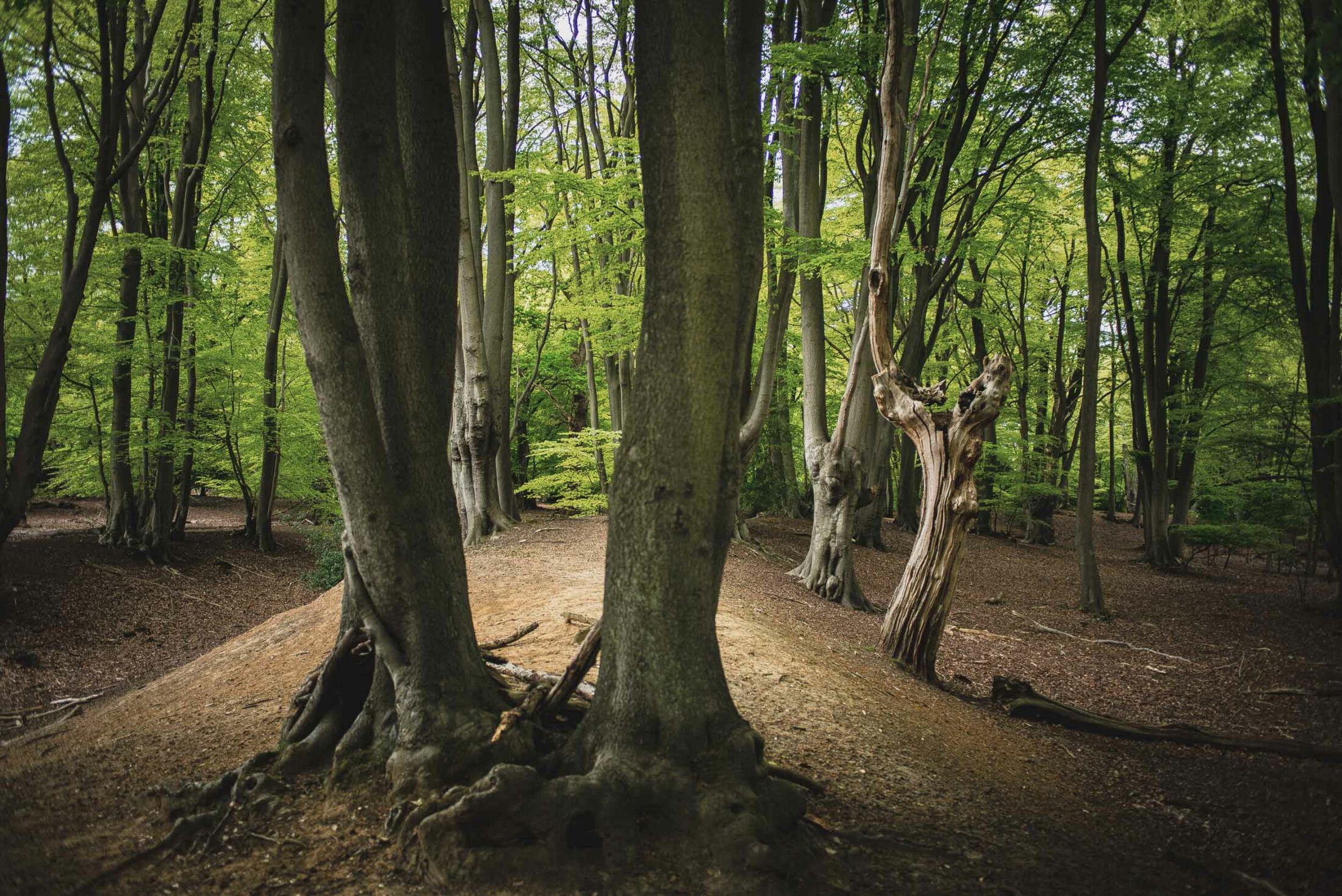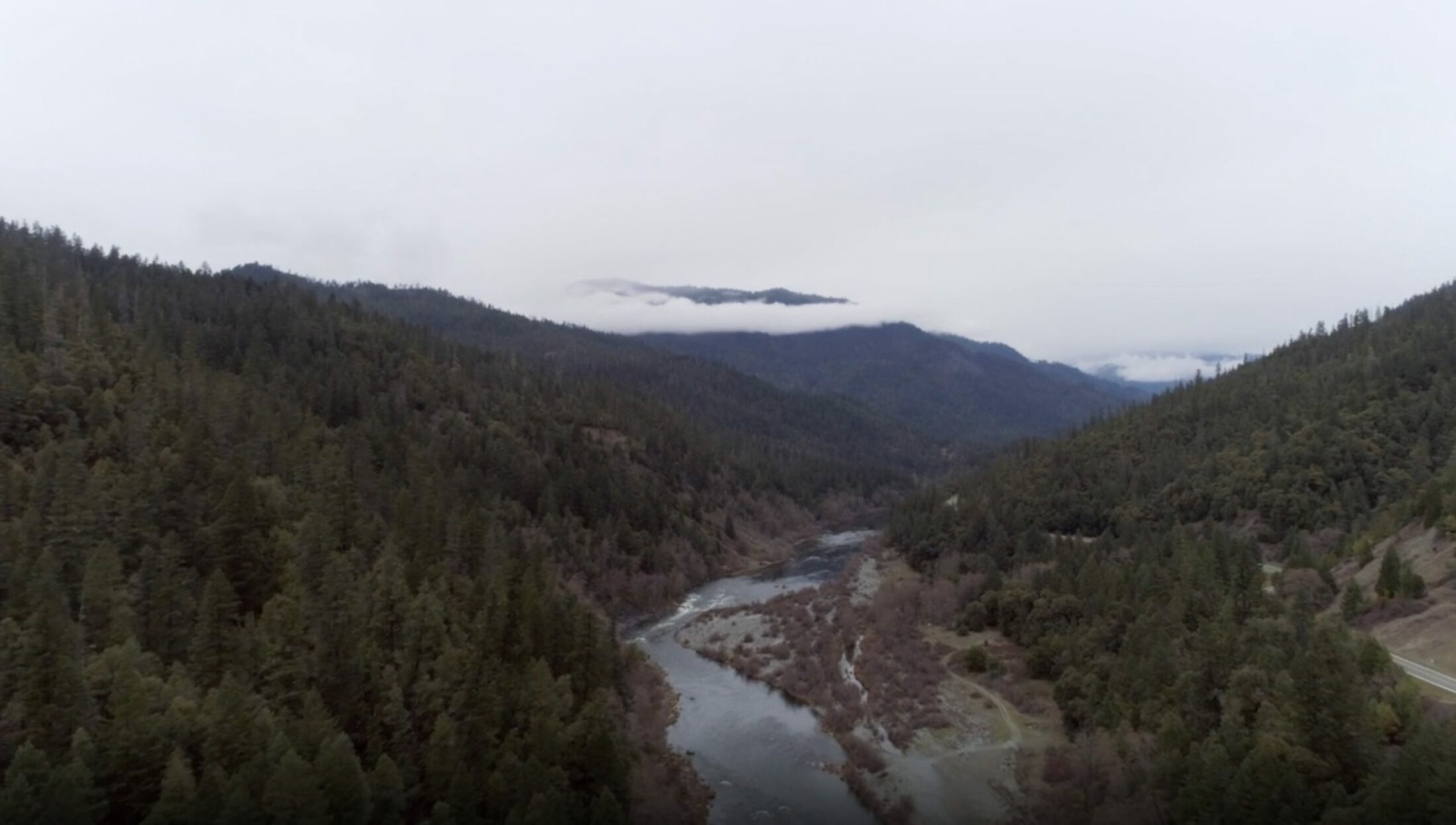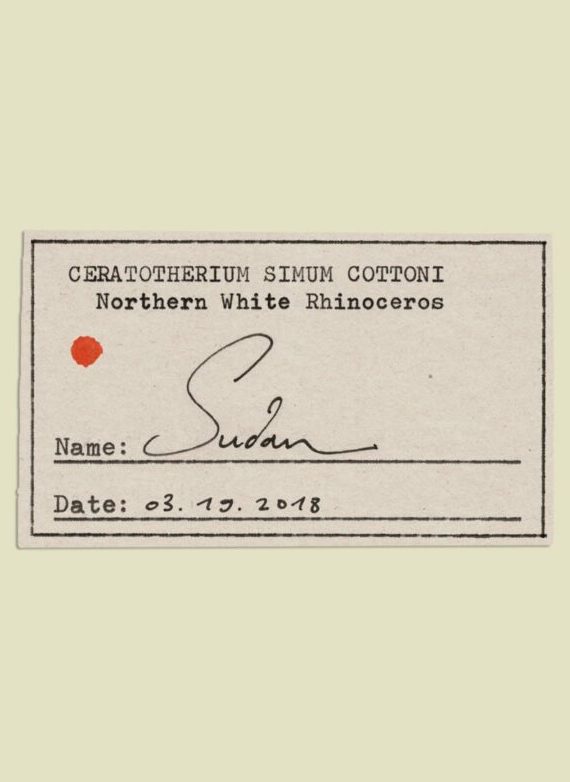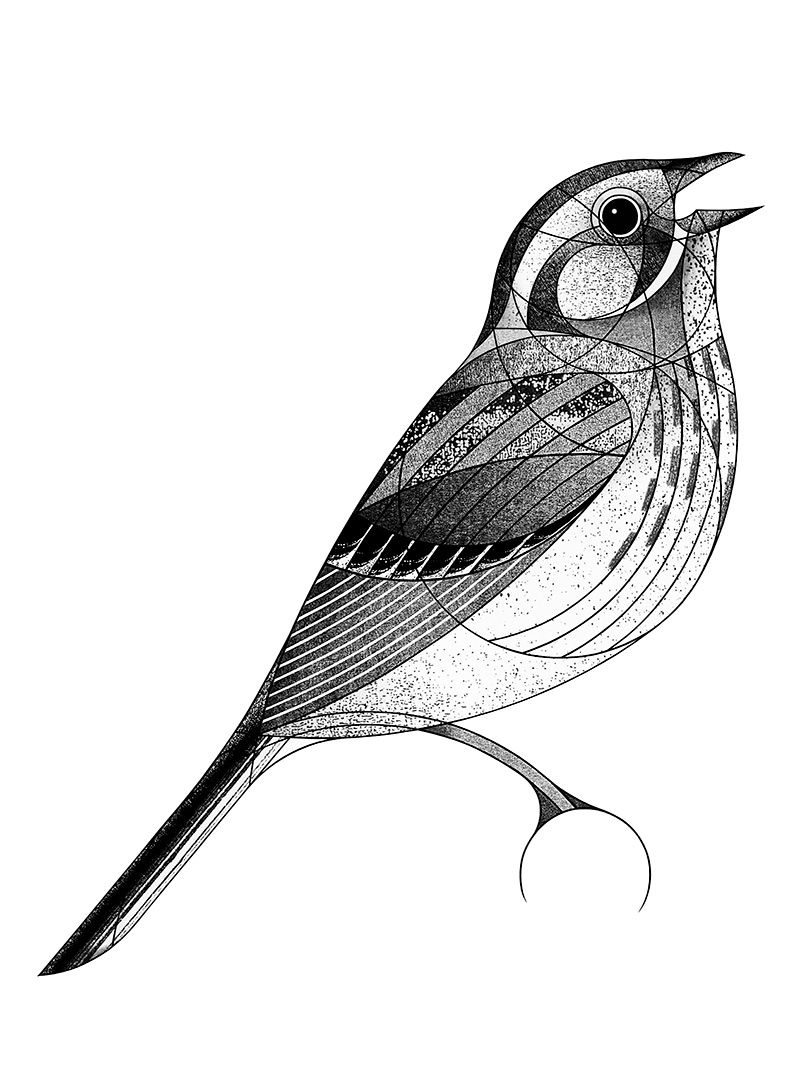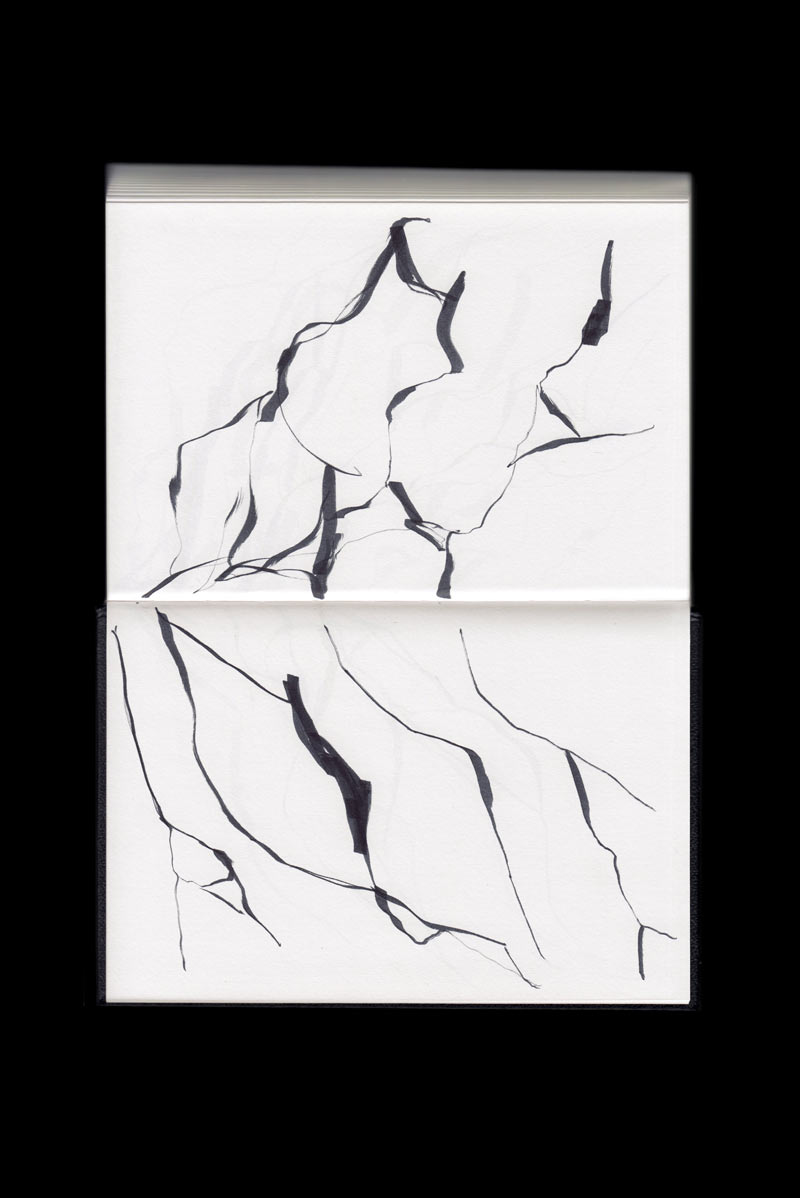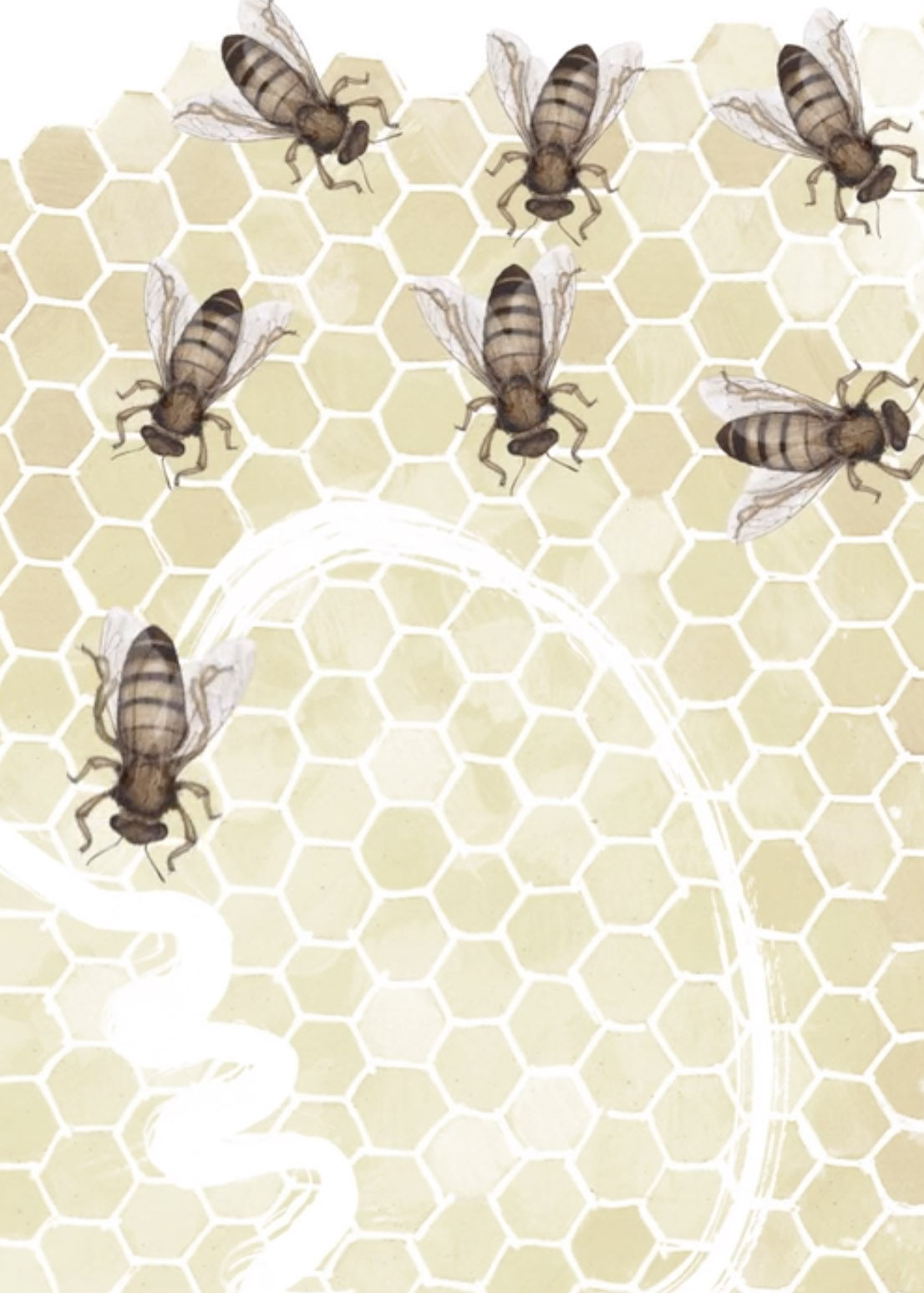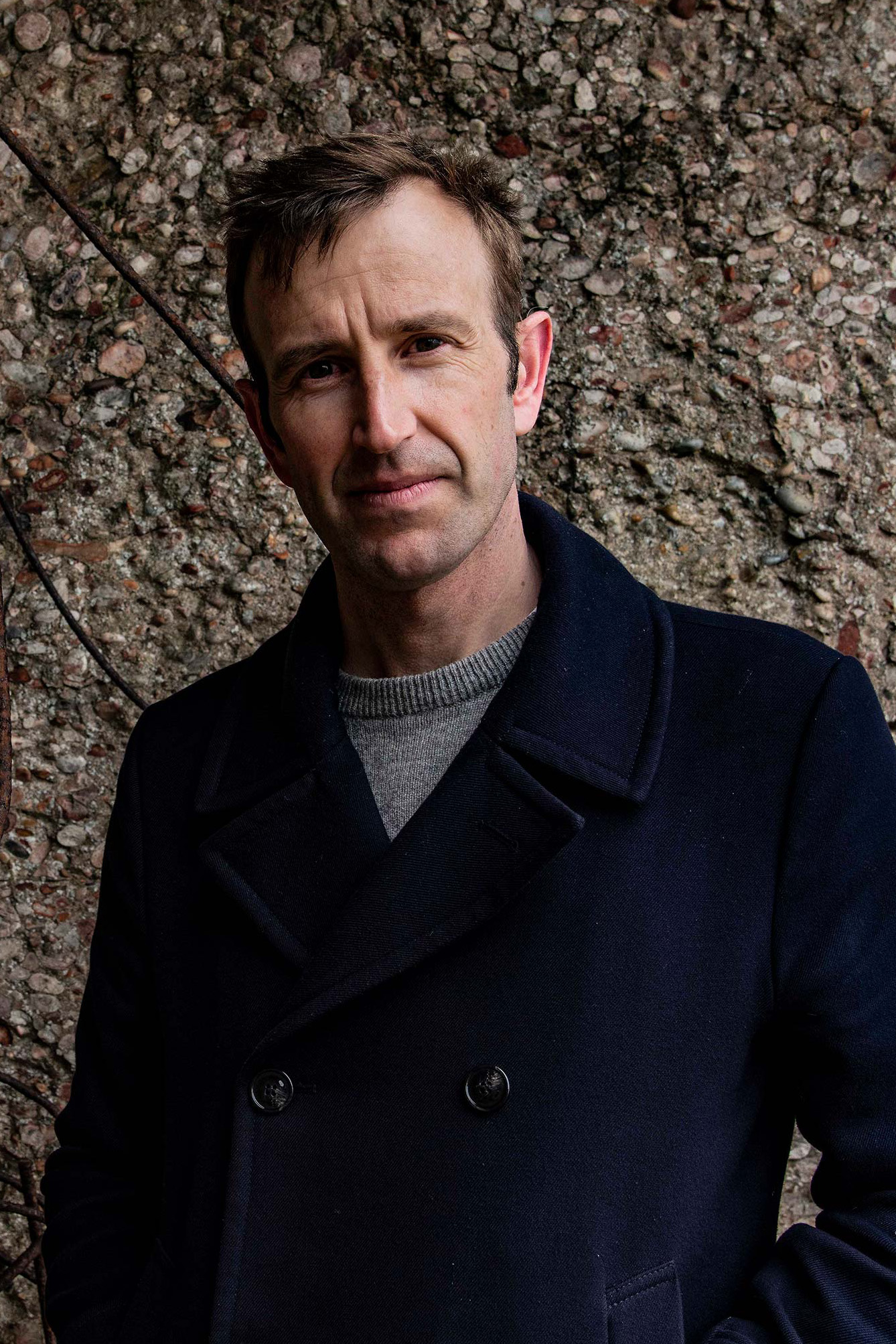
Robert Macfarlane is the author of books on nature, place, and people, including Underland: A Deep Time Journey; The Lost Words (with Jackie Morris); The Old Ways; The Wild Places; Mountains of the Mind; Landmarks; and most recently, Is a River Alive? His work has been widely adapted for film, television, music, dance, and stage, and translated into many languages. Robert won the 2017 E.M. Forster Award for Literature from the American Academy of Arts and Letters, and his writing has appeared in The New Yorker, Granta, and The Guardian. He is a core member of the MOTH (More Than Human) Life Collective and wrote the lyrics for “Song of the Cedars.” He lives in Cambridge, England, where he is a Fellow of the University of Cambridge.
Diane Barker is a photographer and artist, based in Worcestershire in England. For the past twenty-five years, her work has focused on the Tibetan people and, in particular, Tibetan nomads. Diane has shown her work extensively around the UK, as well as in India and New York, and has work in private and public collections around the world.
Excerpted from his recently published book, Underland: A Deep Time Journey, “The Understory” is an examination of the life beneath the forest floor. Encountering the depth and complexity of communication that happens underground, Robert returns to the entangled mutualism at the root of language.
Occasionally—once or twice in a lifetime if you are lucky—you encounter an idea so powerful in its implications that it unsettles the ground you walk on.
The first time I heard anyone speak of the “wood wide web,” more than a decade ago now, I was trying not to cry. A beloved friend was dying too young and too quickly. I had gone to see him for what I took to be the last time. He was tired by pain and drugs. We sat together, talked. My friend was a woodsman. Trees grew through his life and thought. His grandfather’s surname was Wood, he lived in a timber-framed house that he had built himself, and he had planted thousands of trees by hand over the years. “I have sap in my veins,” he wrote once.
That day I read aloud a poem that was important to us both, “Birches” by Robert Frost, in which climbing the snow-white trunks of birches becomes both a readying for death and a declaration of life. Then he told me about new research he had recently read concerning the interrelations of trees: how, when one of their number was sickening or under stress, they could share nutrients by means of an underground system that conjoined their roots beneath the soil, thereby sometimes nursing the sick tree back to health. It was a measure of my friend’s generosity of spirit that—so close to death himself—he could speak unjealously of this phenomenon of healing. He did not have the strength then to tell me the details of how this belowground sharing operated—how tree might invisibly reach out to tree within the soil. But I could not forget the image of that mysterious buried network, joining single trees into forest communities. It was planted in my mind, and there took root. Over the years I would encounter other mentions of the same extraordinary idea, and gradually these isolated fragments began to connect together into something like understanding.
In the early 1990s a young Canadian forest ecologist called Suzanne Simard, studying the understory of logged temperate forests in northwest British Columbia, observed a curious correlation. When paper birch saplings were weeded out from clear-cut and reseeded plantations, their disappearance coincided with first the deterioration and then premature deaths of the planted Douglas fir saplings among which they grew.
Foresters had long assumed that such weeding was necessary to prevent the young birches (the “weeds”) depriving the young firs (the “crop”) of valuable soil resources. But Simard began to wonder whether this simple model of competition was correct. It seemed to her plausible that the paper birches were somehow helping rather than hindering the firs: when they were removed, the health of the firs suffered. If this interspecies aid-giving did exist between trees, though, what was its nature—and how could individual trees extend help to one another across the spaces of the forest?
Simard decided to investigate the puzzle. Her first task was to establish some kind of structural basis for possible connections between the trees. Using microscopic and genetic tools, she and her colleagues peeled back the forest floor and peered below the understory, into the “black box” of the soil—a notoriously challenging realm of study for biologists. What they saw down there were the pale, superfine threads known as “hyphae” that fungi send out through the soil. These hyphae interconnected to create a network of astonishing complexity and extent. A teaspoonful of soil could hold up to seven miles of hyphae.
For centuries, fungi had generally been considered harmful to plants: parasites that caused disease and dysfunction. As Simard began her research, however, it was increasingly thought that certain kinds of common fungi might exist in subtle mutualism with plants. The hyphae of these so-called “mycorrhizal” fungi were understood not only to infiltrate the soil, but also to weave into the tips of plant roots at a cellular level—thereby creating an interface through which molecular transmission might occur. By means of this weaving, too, the roots of individual plants or trees were joined to one another by a magnificently intricate subterranean system.
Simard’s inquiries confirmed that beneath her forest floor there did indeed exist what she called an “underground social network,” a “bustling community of mycorrhizal fungal species” that linked sapling to sapling. She also discovered that the hyphae made connections between species: joining not only paper birch to paper birch and Douglas fir to Douglas fir, but also fir to birch and far beyond—forming a non-hierarchical network between numerous kinds of plants.
Simard had established a structure of connection between the saplings. But the hyphae provided only the means of mutualism. Its existence did not explain why the fir saplings faltered when the birch saplings were weeded out, or details as to what—if anything—might be transmitted via this collaborative system. So Simard and her team devised an experiment that could let them track possible biochemical movements along this invisible buried lattice. They decided to inject fir trees with radioactive carbon isotopes. Using mass spectrometers and scintillation counters, they were then able to track the flow of carbon isotopes from tree to tree.
What this tracking revealed was astonishing. The carbon isotopes did not stay confined to the individual trees into which they were injected. Instead, they moved down the trees’ vascular systems to their root tips, where they passed into the fungal hyphae that wove with those tips. Once in the hyphae they traveled along the network to the root tips of another tree, where they entered the vascular system of that new tree. Along the way, the fungi drew off and metabolized some of the photosynthesized resources that were moving along their hyphae; this was their benefit from the mutualism.
Here was proof that trees could move resources around between one another using the mycorrhizal network. The isotope tracking also demonstrated the unexpected intricacy of the interrelations. In a research plot thirty meters square, every single tree was connected to the fungal system, and some trees—the oldest—were connected to as many as forty-seven others. The results also solved the puzzle of the fir–birch mutualism: the Douglas firs were receiving more photosynthetic carbon from paper birches than they were transmitting. When paper birches were weeded out, the nutrient intake of the fir saplings was thus—counterintuitively—reduced rather than increased, and so the firs weakened and died.
The fungi and the trees had “forged their duality into a oneness, thereby making a forest,” wrote Simard in a bold summary of her findings. Instead of seeing trees as individual agents competing for resources, she proposed the forest as a “cooperative system,” in which trees “talk” to one another, producing a collaborative intelligence she described as “forest wisdom.” Some older trees even “nurture” smaller trees that they recognize as their “kin,” acting as “mothers.” Seen in the light of Simard’s research, the whole vision of a forest ecology shimmered and shifted—from a fierce free market to something more like a community with a socialist system of resource redistribution.
Simard’s first major paper on the subject was published in Nature in 1997, and it was from there that the subterranean network of tree–fungus mutualism gained its durable nickname of “the wood wide web.” Her Nature paper was a groundbreaking publication, the implications of which were so significant that an entire research field subsequently formed to pursue them. Since then the scientific study of belowground ecology has boomed. New technologies of detection and mapping have illuminated fresh details of this “social network” of trees and plants. “The wood wide web has been mapped, traced, monitored and coaxed,” as Simard puts it, “to reveal the beautiful structures and finely adapted languages of the forest network.”
And among this new generation of the forest’s linguists and mappers is a young plant scientist called Merlin Sheldrake. Truly, that is his name.
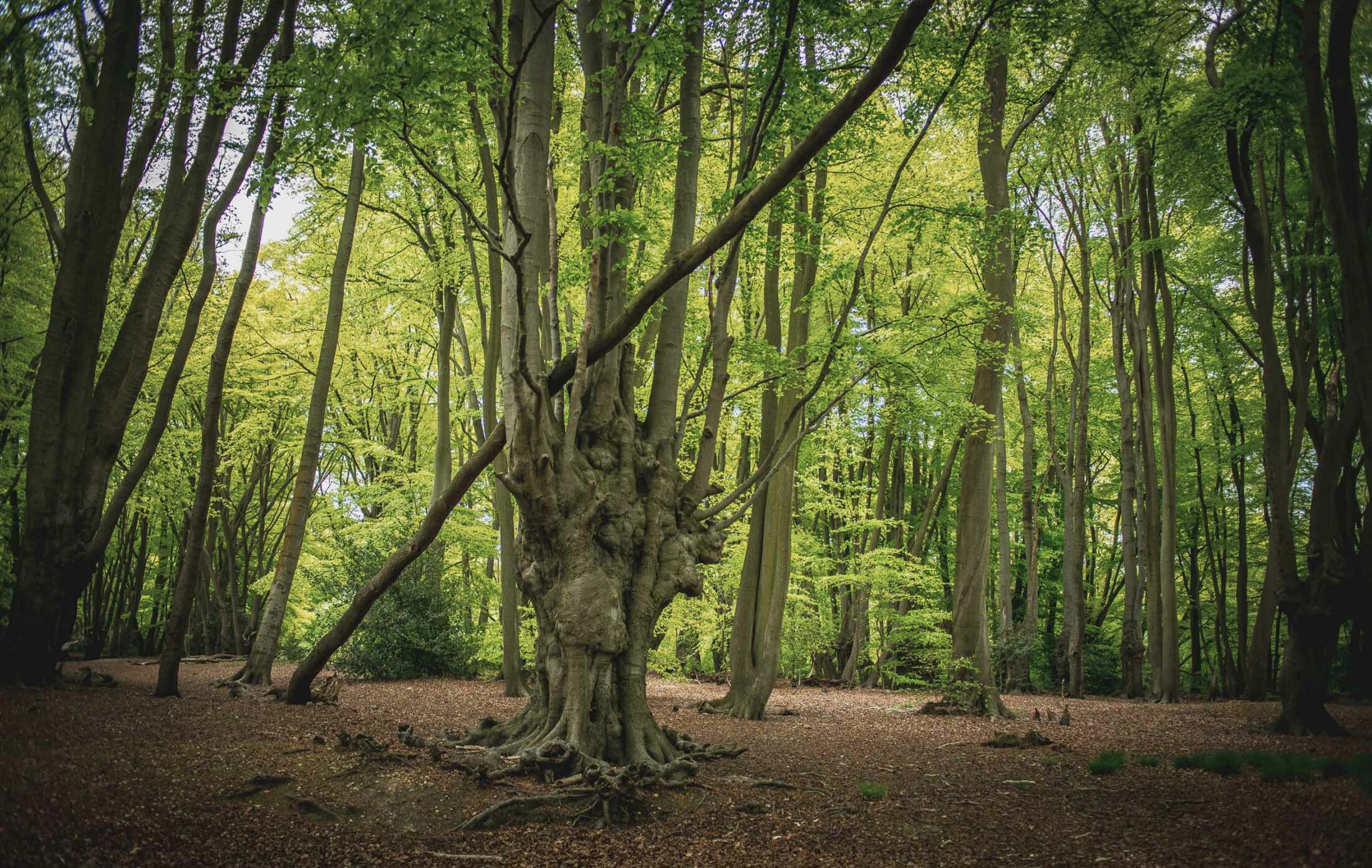
I could not forget the image of that mysterious buried network, joining single trees into forest communities.
Merlin and I stand side by side in a beech coppice—the biggest I have ever seen, let alone entered. The stool is ten yards from one end to another, the tree perhaps 400 or 500 years old.
“I’d guess this hasn’t been coppiced for at least half a century,” I say to Merlin.
Coppice shoots have grown, unlopped, into upright trunks, raying up around the edge of the coppice’s base and leaving a space in the center easily big enough to hold us both. We stay there for a while, enjoying being inside this ancient tree, looking out at Epping Forest from between the gray-barked bars of our cage.
Two of the beech’s lower limbs have melted into one another, their bark conjoining into a single continuous skin, their vascular systems growing and uniting. Living wood, left long enough, behaves as a slow-moving fluid. Like glacial ice—like the halite I had seen in Boulby, like the calcite I had seen in the Mendips, like stained glass in medieval churches which, over centuries, gradually thickens out at the base of each pane—living wood flows, given time. “I’ve heard this called ‘pleaching,’” I say to Merlin, patting the fused branches. “The artist David Nash planted a circle of ash trees in a clearing in North Wales, then bent and wove the trees so that they grew not just next to one another but into one another, a dancing ‘Ash Dome,’ made of a meld of boughs and limbs.”
“Actually,” says Merlin, “plant scientists have a technical term for this. We call it ‘snogging,’ or to give it its full name, ‘tree snogging.’” He smiles. “Well, not quite. The technical term is actually ‘inosculation,’ from the Latin osculare, meaning ‘to kiss.’ Inosculation means ‘to en-kiss.’ It can happen across trees and between species too.”
Though I know the word “inosculation,” I had not known its etymology; what seemed a chilly specialist term gains a passionate warmth, and feels true to this arboreal “en-kissing,” which makes it hard to say where one being ends and another begins. I think of Ovid’s version of the “Baucis and Philemon” myth, in which an elderly couple are transformed into an intertwining oak and linden, each supporting the other in terms of both structure and sustenance, drawing strength for each other from the ground through their roots—and tenderly sharing that strength through their en-kissing. “This kind of merging happens belowground too,” says Merlin, “but probably more intensely between the roots of the trees than between branches, because space is more limited belowground and the crisscrossing will be denser. And it happens vastly more profusely in the fungal networks, often between quite different species.” He follows the pleaching of the two branches with a finger.
“From being two hyphal tubes, two fungi are suddenly one, and things can start flowing between them, including genetic material and nuclei. This is why it’s so hard to deal with species concepts in fungi, or even the question of what an organism is—because while fungi do the sex thing, they also have this wildly promiscuous horizontal transfer of genetic material that is unpredictable in a still ill-understood way.”
Merlin Sheldrake, as the oldest joke in mycology goes, is a fun guy to be around. During the days in which he conjures open the underland of Epping Forest for me, I ask more questions than I have of anyone for what feels like years. What he tells and shows me in that modest peri-urban forest reshapes my sense of the world in ways I am still processing.
The night of Merlin’s birth was three days after the Great Storm of 15 October 1987, when hurricane-force winds, gusting to strengths of 120 mph, capsized carriers, drove ferries ashore, and felled some 15 million trees—ripping up the forest floor across southern England and northern France and tilting it skywards in the form of root plates. The first full day of Merlin’s life was “Black Monday,” when the Dow Jones suffered a record fall, wiping trillions off global wealth and triggering a crash in financial markets worldwide.
No, the omens of Merlin Sheldrake’s arrival into the world were not auspicious. In Greek myth he would surely have been fated to be a force for destruction and ruin. But he was given a magical name and he grew into a magical person. He is tall, slim, and very upright in his bearing. He has tight curls of dark hair, intense eyes with full circles of white visible around each iris, and a wide, warm grin. He is also a formidable scientist, with a doctorate in Plant Science from Cambridge. There is something faintly antiquarian to him—a disinterest in disciplinary boundaries, a boundless curiosity—and something of the heroic-age plant hunter too. He puts me in mind of a cross between Sir Thomas Browne and Frank Kingdon-Ward, collector of Meconopsis betonicifolia, the legendary blue poppy of the Himalayas.
It is typical of Merlin that he became fascinated from a young age not with the charismatic megafauna of the world, but instead with the undersung, underseen inhabitants of the biota: lichens, mosses, and fungi. He studied them as an amateur teenage scientist, counting lichen species on gravestones and granite boulders, and trying to comprehend the subterranean architecture of fungal life—aboveground mushrooms as fruiting bodies that stand as mere fleeting allusions to immense underland structures.
“My childhood superheroes weren’t Marvel characters,” Merlin once said to me, “they were lichens and fungi. Fungi and lichen annihilate our categories of gender. They reshape our ideas of community and cooperation. They screw up our hereditary model of evolutionary descent. They utterly liquidate our notions of time. Lichens can crumble rocks into dust with terrifying acids. Fungi can exude massively powerful enzymes outside their bodies that dissolve soil. They’re the biggest organisms in the world and among the oldest. They’re world-makers and world-breakers. What’s more superhero than that?”
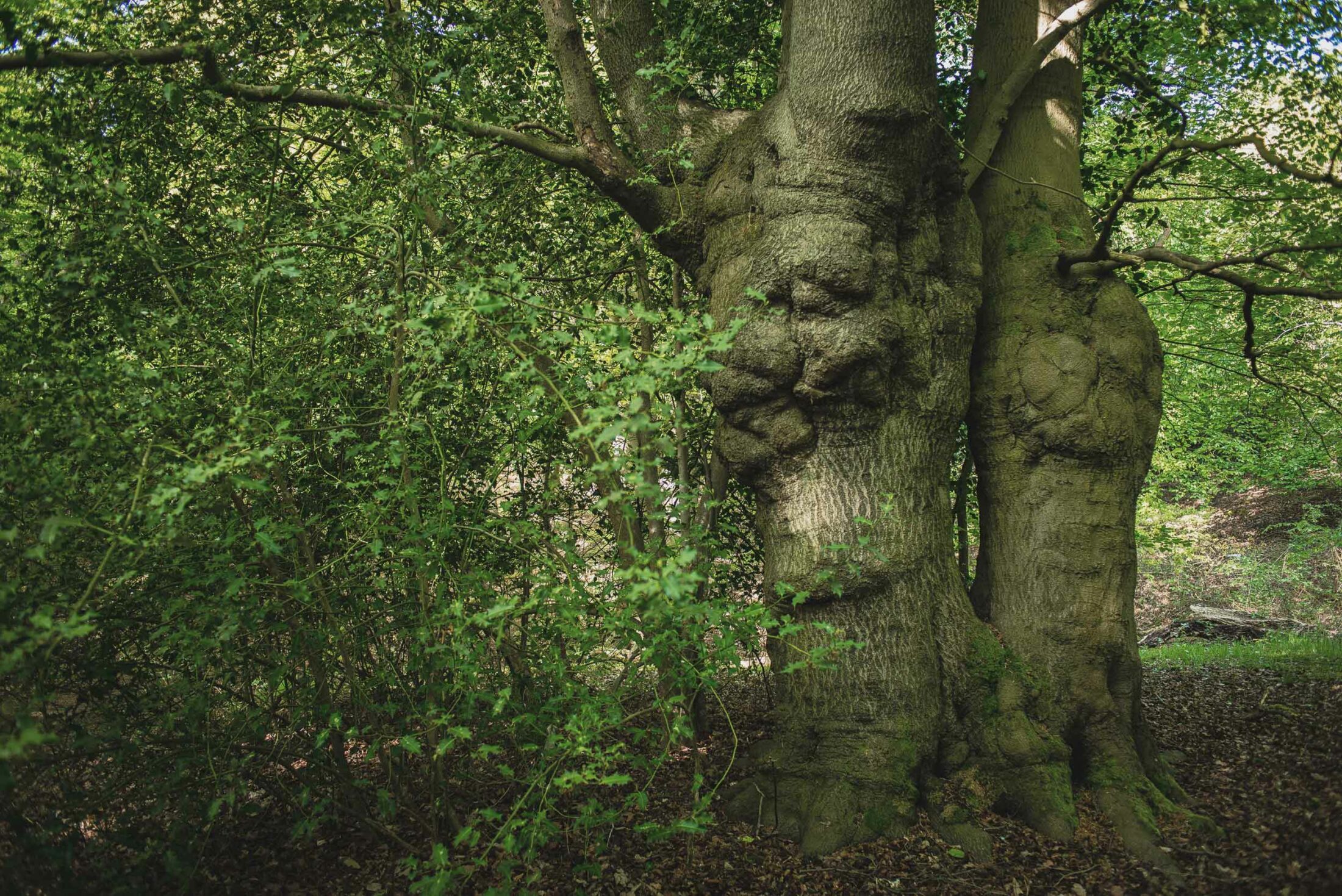
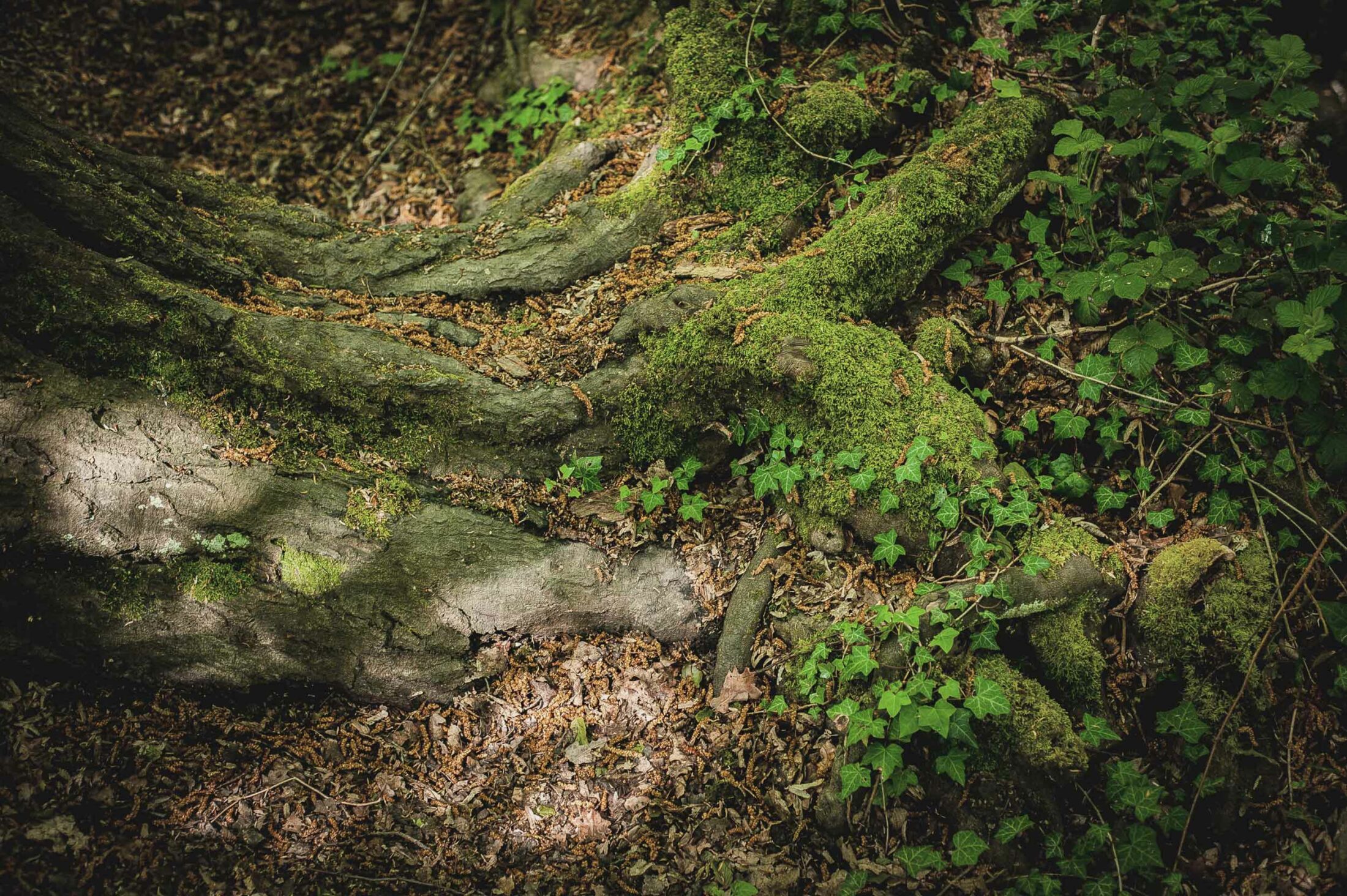

Merlin and I set off on foot into Epping Forest one morning from a high clearing, heading roughly north, keeping the sun to the right of our line.
Epping extends to the northeast of London, and it is very far from a wildwood. It was first designated as a royal hunting forest in the twelfth century by Henry II, with penalties for poaching that included imprisonment and mutilation. Presently it is managed by the City of London Corporation, and has more than fifty bylaws governing behavior within its bounds—though the punishments are now fiscal rather than corporal. It is fully contained within the M25, the orbital motorway that encircles outer London. Minor roads traverse it, and it is never more than two and a half miles wide. Despite its small extent, Epping is easy to get lost in—a forest of forking paths to which, for a thousand years, the people of London and its surrounds have gone for shelter, sex, escape, and a relic greenwood magic.
Growl of roads. Whirr of a low-flying bumblebee, stirring the leaf litter with its downdraft. Buzzard overhead, turning, mewing. Old coppice trees left uncut, hydra-headed pollards. A fallen log, thick with moss; small orange fungi sprouting from wet breaks in its grain. Where trees thin out and light falls, hundreds of green beech seedlings are pushing up through the litter, none more than an inch high. Five fallow deer appear between hollies ahead of us, the dapple of leaf-light flicking off the dapple of their flanks as they move through the understory.
In the language of forestry and forest ecology, the “understory” is the name given to the life that exists between the forest floor and the tree canopy: the fungi, mosses, lichens, bushes, and saplings that thrive and compete in this mid-zone. Metaphorically, though, the “understory” is also the sum of the entangled, ever-growing narratives, histories, ideas, and words that interweave to give a wood or forest its diverse life in culture.
“What interests me most,” says Merlin, “is the understory’s understory.” He points around at the beech, the hornbeam, the chestnut. “All of these trees and bushes,” he says, “are connected with one another belowground in ways we not only cannot see, but ways we have scarcely begun to understand.”
While studying Natural Sciences at Cambridge, Merlin read Simard’s groundbreaking research into the wood wide web. He also read E. I. Newman’s classic 1988 paper, “Mycorrhizal Links between Plants: Their Functioning and Ecological Significance.” There Newman argued against the assumption that “plants are physiologically separate from each other,” proposing instead the existence of a “mycelial network” that might link plants together. “If this phenomenon is widespread,” wrote Newman, “it could have profound implications for the functioning of ecosystems.”
Those “implications” were indeed profound, and they fascinated Merlin. He already loved the alien realm of fungi. He knew that fungi could turn rocks to rubble, could move with swiftness both overground and underground, could reproduce horizontally, and digest food outside their bodies by means of metabolically ingenious excreted acids. He knew that their toxins could kill us, and their psychoactive chemicals could induce hallucinogenic states. The work of Simard and Newman, however, revealed to him that fungi could also allow plants to communicate with one another.
Merlin was taught as an undergraduate by Oliver Rackham, the legendary botanist whose research transformed our understanding of both the cultural and botanical history of the English landscape. Working with Rackham, Merlin found himself most intellectually attracted to places where orthodox evolutionary theory felt thinnest—and for him the thinnest places were where mutualisms were at work. Mutualism is a subset of symbiosis in which there exists between organisms a prolonged relationship that is interdependent and reciprocally beneficial.
“What fascinates me about mutualisms,” says Merlin, “is that one would predict from basic evolutionary theory that they would be massively unstable, and collapse quickly into parasitism. But it turns out that there are very ancient mutualisms, which have remained stable for puzzlingly long times: between the yucca plant and yucca moths, for example, or of course between the bacteria that illuminate the bioluminescent headlamp of the bobtail squid, and the squid itself.”
“Of course,” I reply. “The ancient glowing-bobtail-squid-and-bacteria mutualism.”
“The ultimate mutualism, though,” says Merlin, “is between plants and mycorrhizal fungi.”
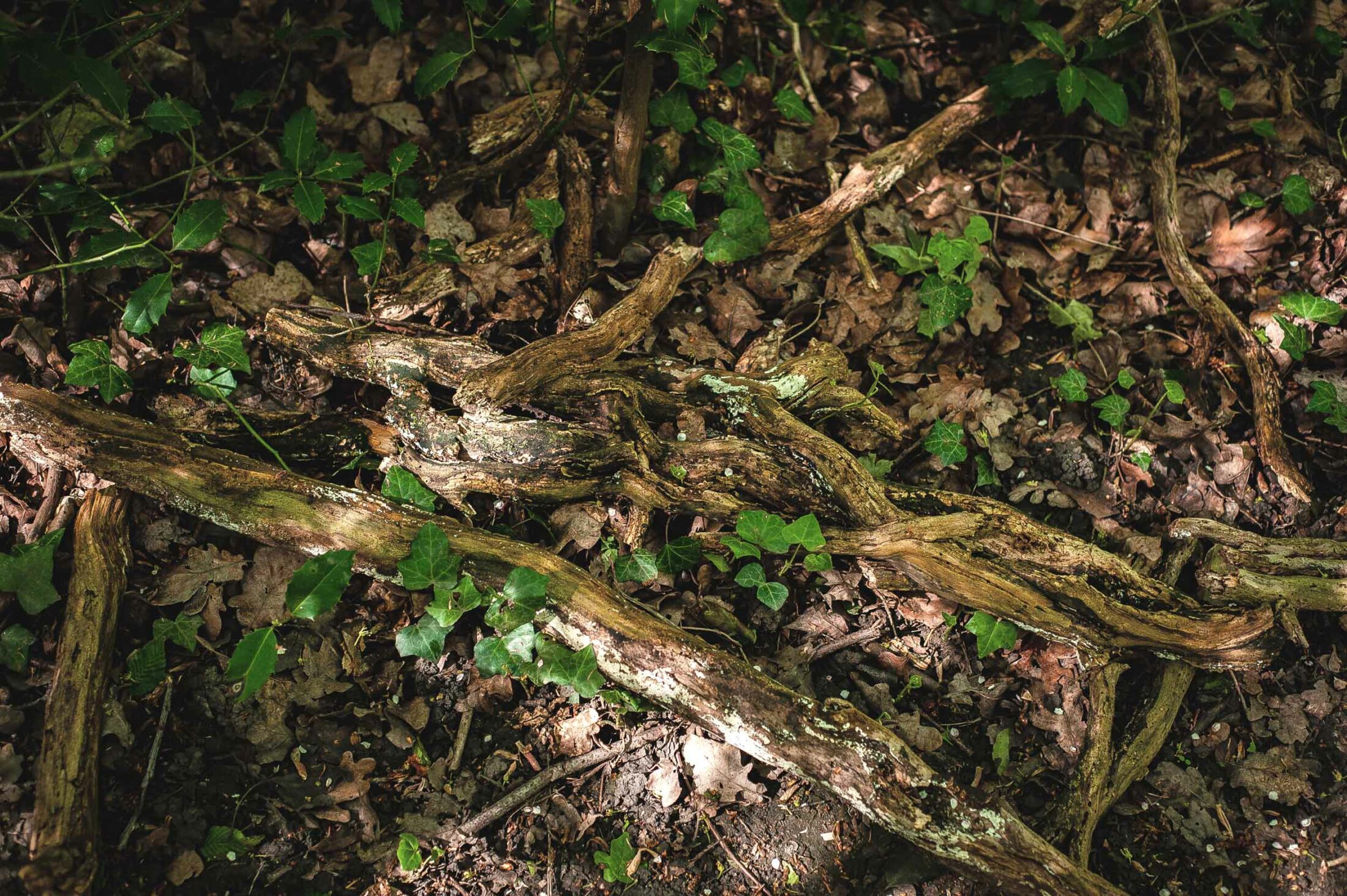
The possibilities of the wood wide web far exceed this basic exchange of goods between plant and fungi.

The term “mycorrhiza” is made from the Greek words for “fungus” and “root.” It is itself a collaboration or entanglement; and as such a reminder of how language has its own sunken system of roots and hyphae, through which meaning is shared and traded.
The relationship between mycorrhizal fungi and the plants they connect is ancient—around 450 million years old—and largely one of mutualism. In the case of the tree–fungi mutualism, the fungi siphon off carbon that has been produced in the form of glucose by the trees during photosynthesis, by means of chlorophyll that the fungi do not possess. In turn, the trees obtain nutrients such as phosphorus and nitrogen that the fungi have acquired from the soil through which they grow, by means of enzymes that the trees lack.
The possibilities of the wood wide web far exceed this basic exchange of goods between plant and fungi, though. For the fungal network also allows plants to distribute resources between one another. Sugars, nitrogen, and phosphorus can be shared between trees in a forest: a dying tree might divest its resources into the network to the benefit of the community, for example, or a struggling tree might be supported with extra resources by its neighbors.
Even more remarkably, the network also allows plants to send immune-signaling compounds to one another. A plant under attack from aphids can indicate to a nearby plant via the network that it should up-regulate its defensive response before the aphids reach it. It has been known for some time that plants communicate aboveground in comparable ways, by means of diffusible hormones. But such airborne warnings are imprecise in their destinations. When the compounds travel by fungal networks, both the source and recipient can be specified. Our growing comprehension of the forest network asks profound questions: about where species begin and end, about whether a forest might best be imagined as a super-organism, and about what “trading,” “sharing,” or even “friendship” might mean between plants and, indeed, between humans.
The anthropologist Anna Tsing likens the belowground of a forest to “a busy social space,” where the interaction of millions of organisms “forms a cross-species world underground.” “Next time you walk through a forest,” she writes memorably in an essay called “Arts of Inclusion, or How to Love a Mushroom,” “look down. A city lies under your feet.”
Just a few inches of soil is enough to keep startling secrets.
Merlin and I have been walking the forest for two hours or so when we reach one of Epping’s great pollard beech groves. Pollarding—the pruning of the upper branches of a tree to promote dense growth—keeps trees alive for longer, indeed can enter them into an almost indefinite fairy-tale time of longevity. Here in the grove, long waving trunks yearn up to the sun. Through their leaves falls a green sub-sea light. It feels as if we are swimming through a kelp forest.
We stop and lie down for a while on the woodland floor, on our backs, not speaking, watching the trees’ gentle movements in the breeze, and the light lacing and lancing from fifty feet or more above us. Where the pollards spread out to form the canopies, I realize I can trace patterns of space running along the edges of each tree’s canopy: the beautiful phenomenon known as “crown shyness,” whereby individual forest trees respect each other’s space, leaving slender running gaps between the end of one tree’s outermost leaves and the start of another’s.
Lying there among the trees, despite a learned wariness towards anthropomorphism, I find it hard not to imagine these arboreal relations in terms of tenderness, generosity, and even love: the respectful distance of their shy crowns, the kissing branches that have pleached with one another, the unseen connections forged by root and hyphae between seemingly distant trees. I remember something Louis de Bernières has written about a relationship that endured into old age: “we had roots that grew towards each other underground, and when all the pretty blossom had fallen from our branches we found that we were one tree and not two.” As someone lucky to live in a long love, I recognize that gradual growing-towards and subterranean intertwining; the things that do not need to be said between us, the unspoken communication which can sometimes tilt troublingly towards silence, and the sharing of both happiness and pain. I think of good love as something that roots, not rots, over time, and of the hyphae that are weaving through the ground below me, reaching out through the soil in search of mergings. Theirs, too, seems to me then a version of love’s work.
Merlin gets up, walks towards the center of the grove as if looking for something, then bends down and brushes away leaf litter and beech mast, to clear a patch of soil the size of a saucer. I get up and follow him. He pinches some of the earth and rubs it between his fingers. It smears rather than crumbling: a rich, dark humus, made of composted leaves.
“This is our problem when it comes to studying the fungal network,” he says. “Soil is fantastically impenetrable to experiments, and the fungal hyphae are on the whole too thin to see with the naked eye. That’s the main reason it’s taken us so long to work out the wood wide web’s existence, and to discern what it’s doing.”
Rivers of sap flow in the trees around us. If we were right now to lay a stethoscope to the bark of a birch or beech, we would hear the sap bubbling and crackling as it moves through the trunk.
“You can put rhizotrons into the ground to look at root growth,” Merlin says, “but those don’t really give you the fungi, because they’re too fine. You can do belowground laser scanning but, again, that’s too crude for the fungal networks.”
I am reminded once more of how resistant the underland remains to our usual forms of seeing; how it still hides so much from us, even in our age of hyper-visibility and ultra-scrutiny. Just a few inches of soil is enough to keep startling secrets, hold astonishing cargo: an eighth of the world’s total biomass comprises bacteria that live belowground, and a further quarter is of fungal origin.
“We know the network is there,” Merlin says, “but it’s so effortful to track it. So we have to look for clues to the labyrinth—find clever means of following its paths.”
I kneel beside him. I can see dozens of insects just in this small area, the names of most of which I do not know: gleaming spiders and red-bronze beetles battling over the leaves, a woodlouse curled up into a sphere, a green threadworm writhing through the humus.
“It’s roiling with life,” I say to Merlin.
“That’s just the visible life. Hyphae will be growing into the decomposing matter of this half-rotting leaf,” says Merlin, “into those rotting logs and those rotting twigs, and then you’ll have the mycorrhizal fungi whose hyphae grow into hot spots—all of them frothing and tangling and fusing, making a network that’s connecting holly to holly but also to this beech, and to a seedling of something else over there, layering and layering and layering—until, well, it blows your computational brain!”
As Merlin speaks I feel a quick, eerie sense of the world shifting irreversibly around me. Ground shivering beneath feet, knees, skin. If only your mind were a slightly greener thing, we’d drown you in meaning … I glance down, try to trance the soil into transparency such that I can see its hidden infrastructure: millions of fungal skeins suspended between tapering tree roots, their prolific liaisons creating a gossamer web at least as intricate as the cables and fibers that hang beneath our cities. What’s the haunting phrase I’ve heard used to describe the realm of fungi? The kingdom of the gray. It speaks of fungi’s utter otherness—the challenges they issue to our usual models of time, space, and species.
“You look at the network,” says Merlin, “and then it starts to look back at you.”
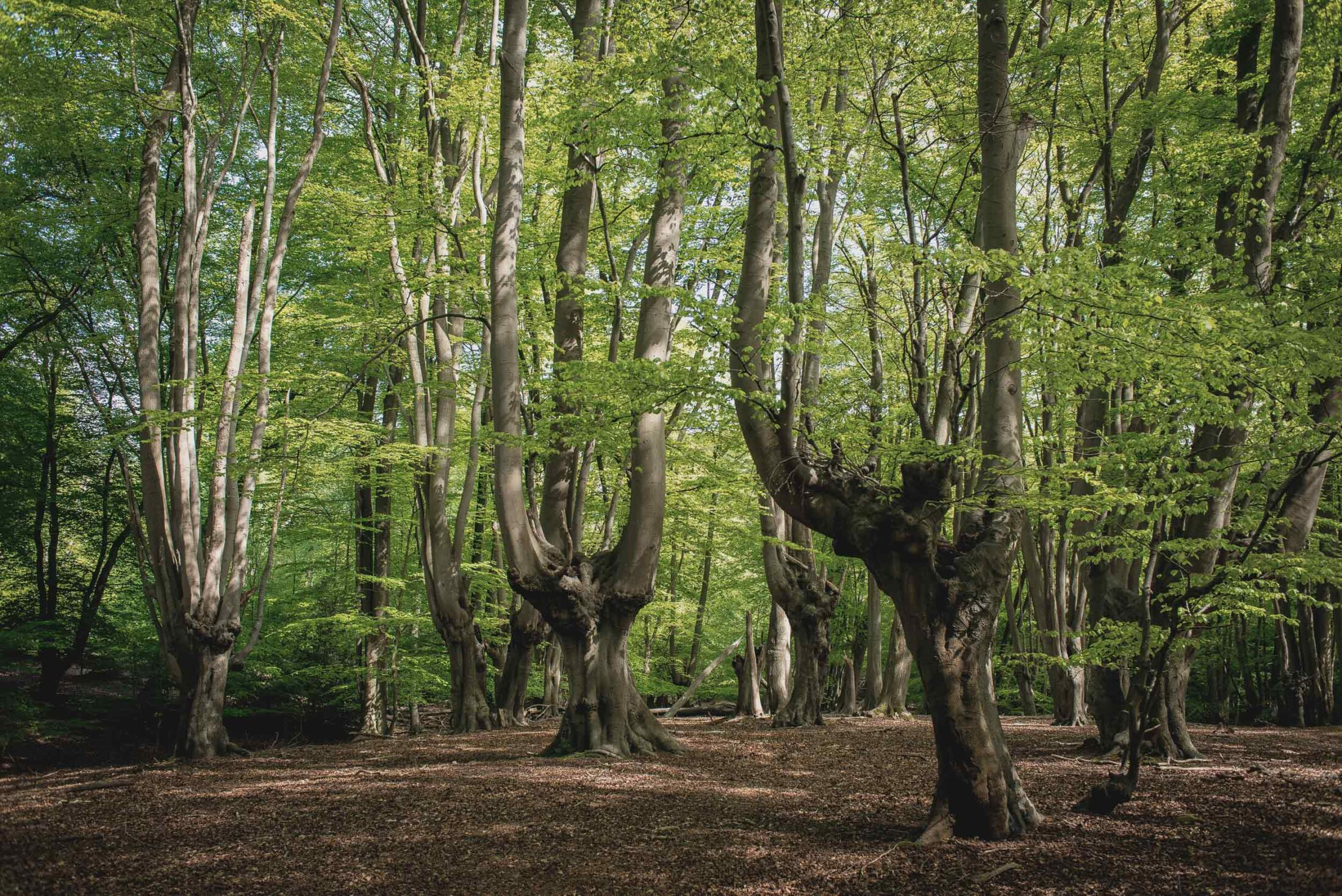
In the underland of the hardwood forests of Oregon’s Blue Mountains there exists a honey fungus, Armillaria solidipes, that is two and a half miles in extent at its widest point, and covers a total lateral area of almost four square miles. The blue whale is to this honey fungus as an ant is to us. It is a deeply mysterious organism: the largest in the world that we know of, and one of the oldest. The best guess that US Forest Service scientists have been able to offer for the honey fungus’s age is between 1,900 and 8,650 years old. The fungus expresses itself aboveground as mushrooms with white-flecked stems rising to tawny, gill-frilled cups. Belowground, where its true extent lies, Armillaria solidipes moves as rhizomorphs resembling black bootlaces, out of which reach the hyphal fingers of its mycelium, spreading in search both of new hosts which they might kill, and the mycelia of other parts of the colony with which they might fuse.
All taxonomies crumble, but fungi leave many of our fundamental categories in ruin. Fungi thwart our usual senses of what is whole and singular, of what defines an organism, and of what descent or inheritance means. They do strange things to time, because it is not easy to say where a fungus ends or begins, when it is born or when it dies. To fungi, our world of light and air is their underland, into which they tentatively ascend here and there, now and then.
Fungi were among the first organisms to return to the blast zone around the impact point in Hiroshima, the point from which the mushroom cloud had risen. After Hiroshima, too, images of the mushroom cloud began to appear ubiquitously in media and culture—the fruiting bodies of a new global anxiety. Scientists working in Chernobyl after the disaster there were surprised to discover fine threads of melanized fungi lacing the distressed concrete of the reactor itself, where radiation levels were over 500 times higher than in the normal environment. They were even more surprised to work out that the fungi were actively thriving due to the high levels of ionizing radiation: that they benefited from this usually lethal gale, increasing their biomass by processing it in some way. Ecologists in the US seeking to understand how American trees will respond to the stress of climate change have begun to focus on the presence of soil fungi as a key indicator of future forest resilience. Recent studies suggest that well-developed fungal networks will enable forests to adapt faster at larger scales to the changing conditions of the Anthropocene.
“Learning to see mosses is more like listening than looking,” writes the ethnobotanist Robin Wall Kimmerer; “mosses … issue an invitation to dwell for a time right at the limits of ordinary perception.” Learning to see fungi seems even harder—requiring senses and technologies that we have yet to develop. Even to try and think with or as fungi is valuable, though, drawing us as it does towards lifeways that are instructively beyond our ken.
Certainly, orthodox “Western” understandings of nature feel inadequate to the kinds of world-making that fungi perform. As our historical narratives of progress have come to be questioned, so the notion of history itself has become remodeled. History no longer feels figurable as a forwards-flighting arrow or a self-intersecting spiral; better, perhaps, seen as a network branching and conjoining in many directions. Nature, too, seems increasingly better understood in fungal terms: not as a single gleaming snow-peak or tumbling river in which we might find redemption, nor as a diorama that we deplore or adore from a distance—but rather as an assemblage of entanglements of which we are messily part. We are coming to understand our bodies as habitats for hundreds of species of which Homo sapiens is only one, our guts as jungles of bacterial flora, our skins as blooming fantastically with fungi.
Yes, we are beginning to encounter ourselves—not always comfortably or pleasantly—as multi-species beings already partaking in timescales that are fabulously more complex than the onwards-driving version of history many of us still imagine ourselves to inhabit. The work of the radical biologist Lynn Margulis and others has shown humans to be not solitary beings, but what Margulis memorably calls “holobionts”—collaborative compound organisms, ecological units “consisting of trillions of bacteria, viruses and fungi that coordinate the task of living together and sharing a common life,” in the philosopher Glenn Albrecht’s phrase.
Little of this thinking is new, however, when viewed from the perspective of animist traditions of indigenous peoples. The fungal forest that science had revealed to Merlin and that Merlin was revealing to me—a forest of arborescent connections and profuse intercommunication—seemed merely to provide a materialist evidence-base for what the cultures of forest-dwelling peoples have known for thousands of years. Again and again within such societies, the jungle or woodland is figured as aware, conjoined, and conversational. “To dwellers in a wood almost every species of tree has its voice as well as its feature,” wrote Thomas Hardy in Under the Greenwood Tree. The anthropologist Richard Nelson describes how the Koyukon people of the forested interior of what we now call Alaska “live in a world that watches, in a forest of eyes. A person moving through nature—however wild, remote … is never truly alone. The surroundings are aware, sensate, personified. They feel.” In such a vibrant environment, loneliness is placed in solitary confinement.
There in the grove with Merlin, I recall Kimmerer, Hardy, and Nelson, and feel a sudden, angry impatience with modern science for presenting as revelation what indigenous societies take to be self-evident. I remember Ursula Le Guin’s angrily political novel, set on a forest planet in which woodland beings known as the Athsheans are able to transmit messages remotely between one another, signaling through the medium of trees. On Athshe—until the arrival of colonists committed to the planet’s exploitation—the realm of mind is integrated into the community of the trees, and “the word for world is forest.”
Language is one of the great geological forces of the Anthropocene.
Four hours into our walk and Epping is playing the usual tricks of forests: disorientation, echoes, a refusal to repeat itself. Often I think we are reversing a path we have already walked, only to find ourselves led into a new area of heath, an unfamiliar grove or thicket. We kick up invisible spores spread by last autumn’s fungi, breathing them into our lungs. We wander so far north that we run out of forest, rebound off the M25, hop a barbed-wire fence, and come to rest in a field that looks as if it is privately owned. We aren’t lost, exactly, but we want to know where the forest widens again.
So I use my phone to summon the satellite network, and pull up a hybrid map of the forest. Sixty-three distinct chemical elements including rare earth metals and minerals mined mostly in China interact within the casing of my device. A blue lanthium dot pulses our location. I pinch and splay the screen to get the right scale. The map shows that the forest flares green to the southwest, so that is where we head—crossing a busy road and then pushing deeper into the trees until we can hardly hear car noise.
In a dry part of the forest, on rising ground, with old pines, beeches, and an understory of holly, we stop to eat and drink, sitting among snaking pine roots. I tell Merlin about Boulby Mine, about the dark-matter lab, the halite tunnels, the men at the face, the geologists sending their probes forwards, falling back from the face, questing in the dark.
“It’s so similar to the way fungi work,” Merlin says, “always prospecting for the most resource-rich or beneficial region, pushing on where they sense benefit. They fan out and if they find a decent seam in one place they die back from the poor areas and concentrate their efforts elsewhere.” He takes my notebook and pen, and draws a diagram of the classic hyphal structure: a branching fan in which it is hard to speak of a main or originary stem, only of shoots and offshoots.
In the second year of his doctorate, Merlin went to conduct fieldwork in the Central American jungle—on Barro Colorado Island, located in the man-made Gatun Lake of the Panama Canal.
“I was so ready to leave the lab for the jungle,” he says. “In a molecular biology lab you’re in near-total control of these little worlds; you’re the giant puppet master making your subject dance to your tune. In the field, though, you’re inside your subject matter and the power relation is totally different.”
On the island Merlin joined a community of field biologists, all of them dancing to the tune of the jungle. He operated under the watchful eye of a grizzled evolutionary biologist called Egbert Giles Leigh Jr, who lived on the base and received new arrivals in his book-lined study, where he played Beethoven on his gramophone and drank whisky-no-ice-no-mixer. This benevolent Kurtz was the island’s archive and overseer.
Some of the science undertaken on the island was methodologically high risk. There was a young American scientist researching what Merlin called “the Drunken Monkey Hypothesis.” Her plan was to collect monkey urine after the monkeys had feasted on fermenting fruit, and to assess the urine for intoxication levels. The problem was that the monkeys tended to urinate from high up in the trees. So she developed a wide-mouthed funnel with which to catch the falling liquid.
“Just to be clear,” I ask, “she was getting drunken monkeys to pee down a funnel from the canopy?”
“Absolutely—and that was very laborious work. She also seemed, you might say, an unlikely candidate for this particular kind of research.”
Then there was someone nicknamed “the Bumblebee Guy,” who trapped bumblebees and stuck adhesive radio-trackers to their abdomens in order to be able to map their feeding and pollinating patterns of movement.
“But the adhesive didn’t stick so well, because the bees were hairy and the air was humid,” says Merlin, “so he then had to capture his bees and shave tiny patches of their abdomens, in order to stick the trackers on more reliably.”
There was also “the Lightning Guy,” who studied the effects of lightning strikes on belowground ecologies, and tried to induce site-specific strikes by firing crossbow bolts trailing copper wire at storm clouds.
“Sounds like a carnival out there,” I say.
“Basically, what you quickly discovered,” Merlin says, “was that if your experiment wasn’t good enough, the jungle would screw it up.”
During his second season on the island, Merlin became interested in a type of plants called “mycoheterotrophs”—“mycohets” for short. Mycohets are plants that lack chlorophyll and thus are unable to photosynthesize. As such they are entirely reliant on the fungal network for their provision of carbon. Some are white, some tinged lilac or violet.
“These little ghosts plug into the fungal network,” Merlin explains, “and somehow derive everything from it without paying anything back, at least in the usual coin. They don’t play by the normal rules of symbiosis—but we can’t prove they’re parasites. You could imagine them as the hackers of the wood wide web.”
Merlin focused on a genus of mycohets called the Voyria, a group of gentians known as “ghost plants,” the flowers of which studded the jungle floor on Barro Colorado Island like pale purple stars. Working with local villagers, he carried out a painstaking census of the soil in a series of plots, sampling and sequencing the DNA of hundreds of root samples taken both from green plants and the Voyria. The census allowed him to determine what species of fungi were connecting with which plants—and thereby to make an unprecedentedly detailed map of the jungle’s social network.
“I only stumbled across the importance of Voyria by accident,” he says, “wandering around one day looking for something else, when I realized that they had almost vanished from a plot from which we’d increased the phosphorus input. That’s how my breakthrough began. Science is full of this stuff: full of happenstance and stumbles and getting knackered and crazy in the field or the lab. It’s so weird to me how science always presents its knowledge as clean.”
A green woodpecker yaffles in the distance.
“I have this plan,” Merlin says, “that for each formal scientific paper I ever publish I will also write its dark twin, its underground mirror-piece—the true story of how the data for that cool, tidy hypothesis-evidence-proof paper actually got acquired. I want to write about the happenstance and the shaved bumblebees and the pissing monkeys and the drunken conversations and the fuck-ups that actually bring science into being. This is the frothy, mad network that underlies and interconnects all scientific knowledge—but about which we so rarely say anything.”

Late in the day we come to a lake in the woods, where a mudbank slopes into shallow water.
Fish sup in the shadows. Moorhens bicker. The lake bed belches gas bubbles. Merlin and I sit facing the setting sun, enjoying its warmth.
Two dog-walkers approach, looking hopeful. “Do you know where the visitors’ center is? We’re lost.”
“No, we’re lost too,” I say happily.
We trade best guesses, share what information we have, and they wander off.
Sitting quietly in the sun, by the lake, I think about the ways we seek to make meaning of the wood wide web. Both of the two main models of interpretation that Merlin has told me about—the “socialist” and the “free-market” models—smuggle a very human politics into a more-than-human science. According to the “free-market” model, the connected forest is to be understood as a competitive system, in which all entities act out of self-interest within a cost-benefit framework, regulating one another by means of “sanction and reward” systems. According to the “socialist” model, by contrast, trees act as carers to one another, sharing resources through the fungal network, with the well-off supporting the needy.
I ask Merlin about this question—about how the politics of representation press especially hard on mycorrhizal studies. It seems to me that what is at stake is not only the relations of nature but also the nature of relations.
“You’re exactly right. In my field, discourse choice forcefully shapes research directions. ‘Sanction and reward,’ for instance, is a central technical concept in mycorrhizal studies, not just an ornament of speech. The metaphor drives the scholarship. I read research papers with titles like ‘Unequal Goods Shared under Common Terms of Trade.’”
“That sounds as if it was commissioned by the Ayn Rand Think Tank,” I say.
“Indeed. Awful. Politically, I’m obviously inclined to dislike the language of biological free-marketry far more than the socialist version,” says Merlin. “Why should we expect fungi and plants to behave as humans started to behave economically in the eighteenth century, with the emergence of the limited liability corporation? I find it so bizarre. It’s one reason I love the Voyria. They demand immediately that you go beyond cost-benefit analysis when thinking about plant life.
“But I’m also skeptical of the socialist dream of fungi as sharing and caring, a rose-tinted vision that sees trees as nurses, every tree a carer to every other, with ‘mother trees’ recognizing and talking with their kin, and ‘injured trees’ selflessly passing on their legacies to neighbors before they die.
“I’m tired of both of these stories,” Merlin says as we leave the lake. “The forest is always more complicated than we can ever dream of. Trees make meaning as well as oxygen. To me, walking through a wood is like taking a tiny part in a mystery play run across multiple timescales.”
“Maybe, then, what we need to understand the forest’s underland,” I say, “is a new language altogether—one that doesn’t automatically convert it to our own use values. Our present grammar militates against animacy; our metaphors by habit and reflex subordinate and anthropomorphize the more-than-human world. Perhaps we need an entirely new language system to talk about fungi … We need to speak in spores.”
“Yes,” says Merlin with an urgency that surprises me, smacking his fist into the palm of his hand. “That’s exactly what we need to be doing—and that’s your job,” he says. “That’s the job of writers and artists and poets and all the rest of you.”
Potawatomi, a Native American language of the Great Plains region, includes the word puhpowee, which might be translated as “the force which causes mushrooms to push up from the earth overnight.” In “all its technical vocabulary,” Robin Wall Kimmerer notes, “Western science has no such term, no words to hold this mystery.”
Kimmerer herself is a member of the Citizen Potawatomi Nation. A speaker of what she calls “fluent botany,” she is careful to distinguish this from what she refers to as “the language of plants”—that is to say, the language that plants speak, as opposed to the language that is used to speak of plants. Kimmerer does not disdain the precisions of botanical lexis, which “polishes the gift of seeing,” but she finds it also to be of necessity a lexis of objectification and distancing, with something missing beneath its finely faceted surface. That missing something is predominantly the acknowledgment of life in the more-than-human world, an indifference which is grained into language not just at the level of individual words, but at the deeper-down levels of grammar and syntax.
In Potawatomi, by contrast, almost all words declare the animacy or inanimacy of that to which they refer. The language is predisposed to recognize life in otherness, and also to extend the reach of that category of “life” far beyond its familiar limits in Western thought. In Potawatomi, not only humans, animals and trees are alive, but so too are mountains, boulders, winds, and fire. Stories, songs, and rhythms are all also animate, they are, they be. Potawatomi is a language abundant with verbs: 70 percent of its words are verbs, compared to 30 percent in English. Wiikwegamaa, for instance, means “to be a bay.” “A bay is a noun only if water is dead,” writes Kimmerer:
trapped between its shores and contained by the word. But the verb … releases the water from bondage and lets it live. “To be a bay” holds the wonder that, for this moment, the living water has decided to shelter itself between these shores, conversing with cedar roots and a flock of baby mergansers.
Like Kimmerer, I wish for a language that recognizes and advances the animacy of the world, “the life that pulses through pines and nuthatches and mushrooms … well[ing] up all around us.” Like Kimmerer, I relish those aspects of discourse that extend being and sentience respectfully and flexibly beyond the usual bearers of such qualities. Like Kimmerer I believe that we need, now, a “grammar of animacy.” A modern predisposition to regard animacy as anomaly runs through what the poet Jeremy Prynne once called “mammal language,” by which he means the language that is used by humans, encoding intent, agency, and muscular power deep in its grammar.
The real underland of language is not the roots of single words, but rather the soil of grammar and syntax, where habits of speech and therefore also habits of thought settle and interact over long periods of time. Grammar and syntax exert powerful influence on the proceedings of language and its users. They shape the ways we relate to each other and to the living world. Words are world-makers—and language is one of the great geological forces of the Anthropocene.
Projects have recently been started around the world to gain even the most basic of vocabularies for the experiences of life and death in the Anthropocene. These stuttering attempts to speak what it is we are doing have generated ugly new terms for an ugly epoch: “geotraumatics,” “planetary dysphoria,” “apex-guilt.” Such words feel like futile forms of nominalism, a hopelessly hyperactive pointing and naming. They stick in the throat in two ways: they are difficult to utter and hard to swallow.
Only one of these recent coinages resonates with me: “species loneliness,” for the intense solitude that we are fashioning for ourselves as we strip the Earth of the other life with which we share it. If there is human meaning to be made of the wood wide web, it is surely that what might save us as we move forwards into the precarious, unsettled centuries ahead is collaboration: mutualism, symbiosis, the inclusive human work of collective decision-making extended to more-than-human communities.
You look at the network, and then it starts to look back at you …
Writing of mycorrhizal fungi, Albrecht proposes that we rechristen the Anthropocene, naming it instead the Symbiocene—an epoch characterized in terms of social organization “by human intelligence that replicates the symbiotic and mutually reinforcing life-reproducing forms and processes found in living systems … such as the wood wide web.”
The word for world is forest.
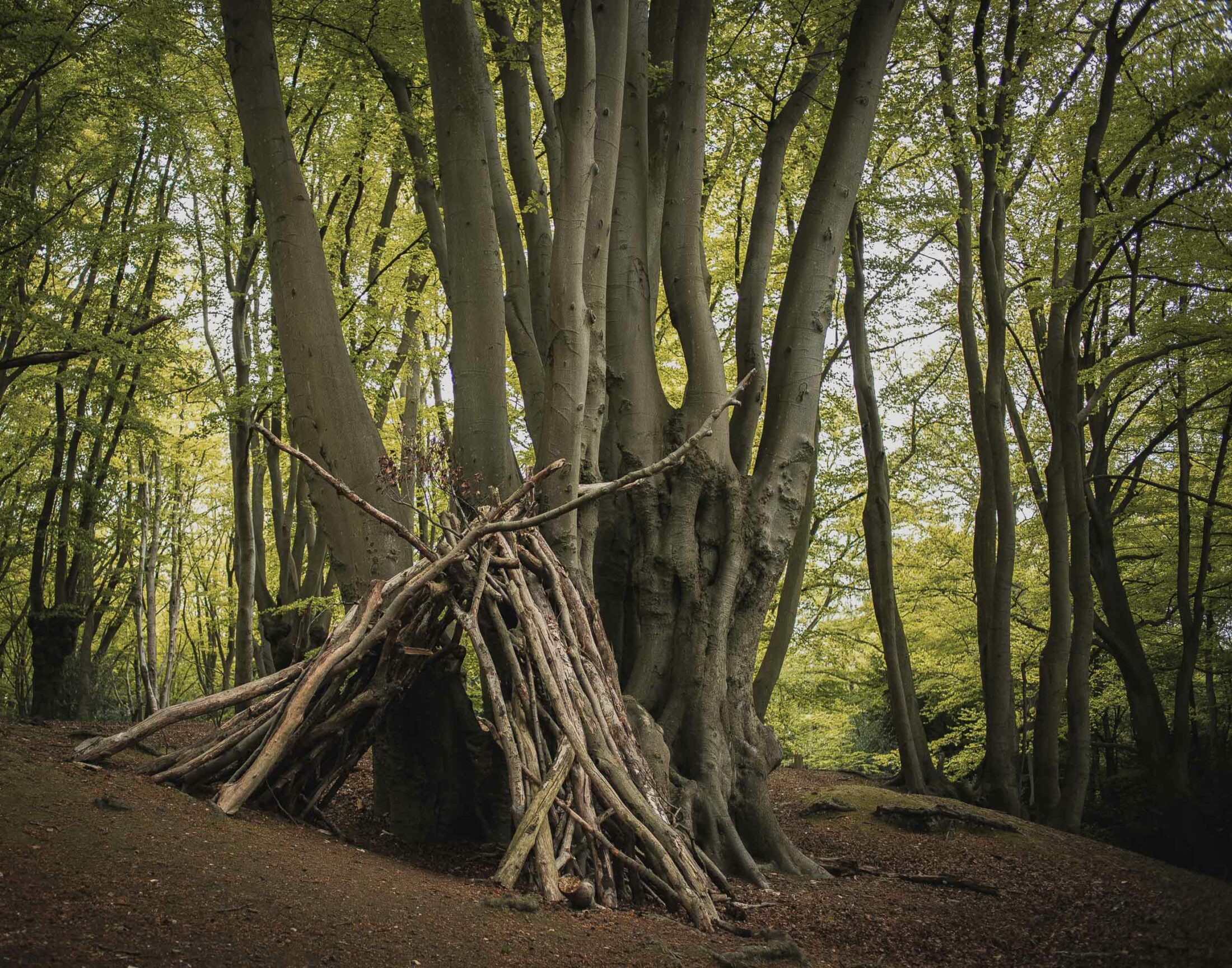
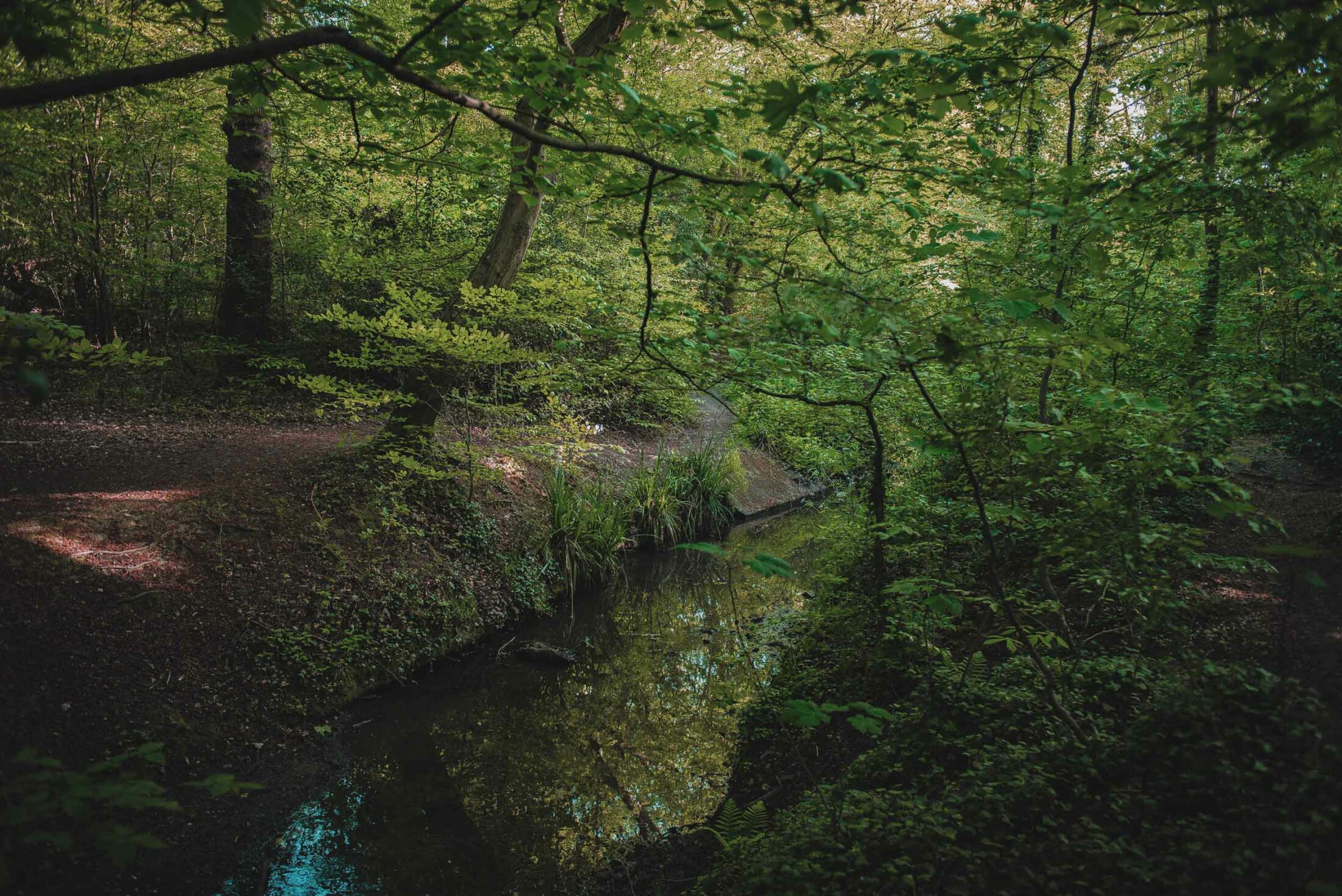
That evening, in a deep part of the woods, far from a road, near an Iron Age earthwork and an old pollard beech grove, on a slope of high ground nicknamed “Friendship Rise,” Merlin and I settle down for the night. We scrape a shallow firepit, haul dead birch trunks around it for seats, and set a small fire going with a tinder of leaves and kindling of twigs, in contravention of Epping Forest bylaws, with murmured apologies to the Corporation of London.
Merlin opens his rucksack and brings out a small decoction bottle containing a dark moss-green liquid. He shakes it.
“Coca extract. Homemade. The perfect pick-us-up after a day among the leaves.”
He reaches again into his bag, and brings out another bottle. “Homemade honey mead,” he says.
He reaches in again, and brings out a third. “Homemade cider,” he says.
The brown glass of the bottle carries a single white label, on which is written the word “Gravity.”
“I pressed this from some windfall apples that had fallen from Newton’s apple tree in Cambridge. It’s quite hard to get to, that tree. It’s in Trinity College. Security is reasonably tight. The scrumping had to be done under cover of night. I wish I could have brought us a bottle of the first ever batch we made. That was from apples scrumped from Darwin’s orchard at Down House. You can probably guess the label name for that batch.”
“Evolution.”
“Bingo.”
People begin to emerge from the shadows of the trees in ones and pairs: friends of mine and friends of Merlin, friends of our friends, invited by social network, by text, by phone, zeroing in on our location using GPS. One brings a harmonica, two bring guitars, and Merlin’s brother brings two sets of bones and a small set of hand drums.
Moths dance around the flames. Satellites blip above us. The red landing lights of planes, visible through the crown shyness, cut paths between the leaves. I have a strong sense of the forest looming around and over and below us.
I drink Merlin’s coca decoction, feel my mind rapidly sharpen. The fire works its magic of storytelling and conviviality. People talk, reestablish existing connections, make new ones, bring into being a temporary community in that fire-braced forest space. I show the whalebone owl and the bronze casket, explain about their giving and the obligations they bring with them. Merlin and I tell some of our day’s understories. Merlin speaks, like Tsing, of the soil as a city, a city beneath our feet in which countless species and kinds of matter are busy interacting.
A young man whose nickname is “the Hand Owl” plays bluegrass on his cupped hands alone, hooting and whooping. Folk songs are sung—“Nine-Pound Hammer,” “Seven Drunken Nights,” “Brown Trout Blues”—with people passing chorus lines and verses from one to another and back again. Merlin plays the bones, clacking a beat for each new song. The night chills us and the fire warms us.
Drums, songs, stories. The trees shifting, speaking, busy making meaning that I cannot hear. Fungi writhing in the birch logs, in the soil.
I sit with my back to a birch log, feet to the fire, next to Tara. Tara is tall, gentle of speech, Greek. She is a singer. She grew up on a small island in the Mediterranean. She learned song and voice from a Russian émigré who had been washed up on the island by the tides of history. She tells me about the consequences for the island of the refugee crisis: the networks of support that were put in place for the refugees, but also the resistance of the islanders who saw the crisis as a threat to their ways of life.
“There reaches a point where you see other humans drowning, or washed ashore with nothing,” says Tara, “where there is no possibility other than to help with all your heart. It isn’t kindness, exactly—because there is less element of choice than people think, and for this reason it is less noble.”
Later, Tara sings a sad song from her island, and my heart breaks a little. The flames die to purring embers.
I am too tired to see the fire to its end, so I wander away into the forest to find somewhere to sleep. Looking back I can see only orange glow, shadows cast against the surrounding trunks—then the firelight dwindles until it is lost in the forest’s dark.
I find myself in a grove of pollard beeches atop a prehistoric earthwork. Under one of them, children have built a den of sticks and boughs, resting them against a low branch to form a crooked timber tent that is long enough for me to sleep in. It is an invitation I cannot refuse, so I creep inside the den and lie down, looking up through its slats at branches, stars, satellites. I feel myself suddenly—strongly—surrounded by beings whose ways of relating to one another are dimly but powerfully perceptible, as if seen through thick gauze. The sensation is at once comforting and lonely-making.
Owl hoot. Dog bark. Back in the clearing the fire dims, song falls silent. The canopy of the pollards spreads above me, whispering in the night breeze. There’s something you need to hear … Seeking sleep, my mind follows leaf to branch, branch to trunk, trunk to root, and from there down along the hyphae that web the earth below.
